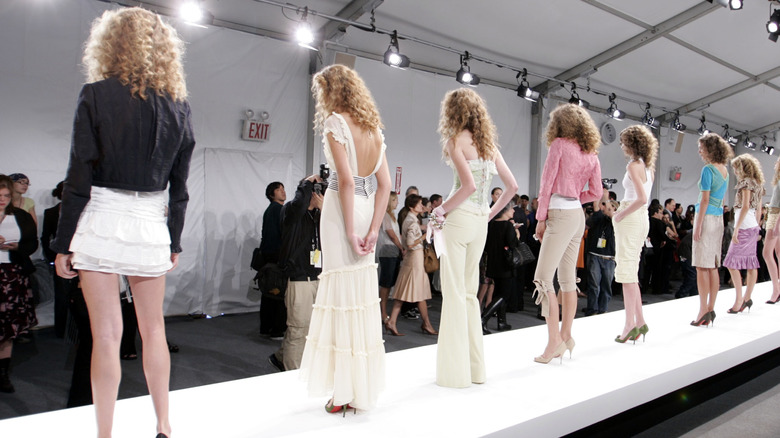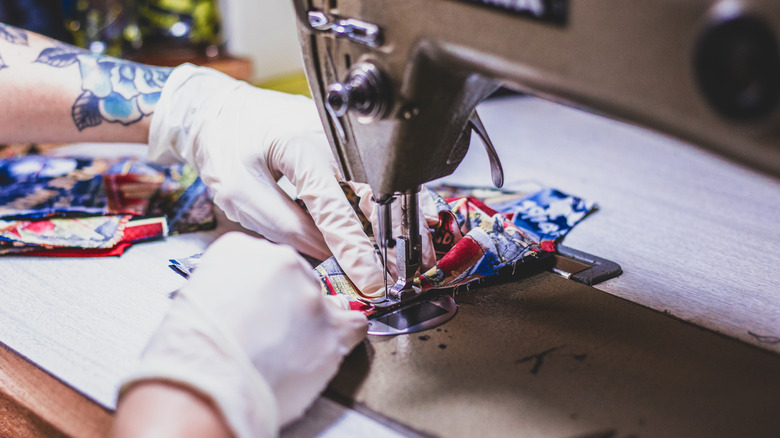Why You Should Ditch Fast Fashion For Slow Fashion
As fashion trends become more short-lived, the production of garments significantly grows bigger and faster everyday to keep up with the demand in consumption. Garments produced quickly like this are often low quality, mass produced without quality control, and cheaper. It is so short lived that they often end up in the landfill after a short amount of time, sometimes after seven to 10 wears. This is known as fast fashion, and it has become a clashing topic with sustainability and slow fashion. This is because fast fashion often pays low, unlivable wages to its outsourced workers and is a contributor to the fashion industry's ranking as the third largest polluter (via Fibre2Fashion).
According to Bloomberg, the fashion industry accounts for up to 10% of global carbon dioxide output. Textile production relies on a petrochemical plastic to be created, and is the second largest product group made from petrochemical plastics. Additionally, polyester, a synthetic fiber derived from petroleum, has now dominated over natural fibers such as cotton. It is expected that polyester production will exceed 92 million tons in the next 10 years, continuing the usage of fossil fuels. Many environmental advocates have started pleading to the public to become aware of the fast fashion impact on the earth. The conversation about fast fashion, slow fashion, and sustainability continues to grow.
What is fast fashion?
In the past, fashion companies would release their new collections at a slower pace throughout the year, specifically split into four seasons: fall, winter, spring, and summer. The Good Trade explains that after working months to produce the latest season's collection, designers and brands would give high society first, exclusive access to it. It wasn't until the 1960s that a glimpse of what would later be recognized as a fast fashion fad was introduced. This phenomenon was known as paper clothing, a form of clothing made with a paper-like fabric meant to be disposable. Fast fashion ramped up and reached a "point of no return" beginning in the 2000s. Today, many fast production brands introduce what The Good Trade described as 52 "micro-seasons" per year, essentially equating to one new collection a week.
Fast fashion is known to be made with low quality fabrics, low wage workers, and at rapid rates to keep up with the cycles of new trends and fads. When something is produced by a higher end brand and then popularized by celebrities or influencers, fast fashion brands replicate the garments in lower quality fabrics to make it an affordable price for consumers. A survey conducted by the Fashion Retail Academy found that 73% of shoppers between 18 and 24 years old and 68% of shoppers between 25 and 34 years old believe influencers are part of the reason for the rise of disposable or fast fashion
Slow fashion and sustainability
In opposition to fast fashion, sustainability advocates encourage consumers to shop what is known as slow fashion. But Byrdie states that the terms "slow fashion" and "sustainability" are not interchangeable, especially when many brands participate in greenwashing. This means that some companies' eco-friendly efforts are mostly just for marketing without taking any sustainable action. "Sustainability is part of slow fashion," professor and author of "Fashion Writing: A Primer," Christina Manley tells Byrdie. "Sustainability focuses primarily on the environmental and human cost of fashion. It looks at whether production of clothing actually harms or helps individuals and the environment, but also brings fashion to the individual level where one not only considers the sustainability of their purchases but the longevity (and possibly the motivation to buy) of an item."
While polyester is used in both fast fashion and even in slower producing high end brands today, slow fashion is about the overall hands-on process of production as well. This includes more intentional design, creation, sourcing, and quality control. Lindsay Jones, designer at Mused and head creative design assistant for Zac Posen, tells Byrdie that "shopping locally and connecting with the people who make our clothes is an amazing way to build community." Connecting with the origins of your clothes, Jones says, helps you think more about the environment.
Transitioning to slow fashion doesn't always mean it has to be an immediate or dramatic change. Christina Manley says that while she primarily focuses on making her own clothes, she still purchases some designer or ready-to-wear items, mixing it up. Slow fashion is about asking people to pause and think about what they are buying. It is about being mindful of your purchase, considering what its impact could be.


